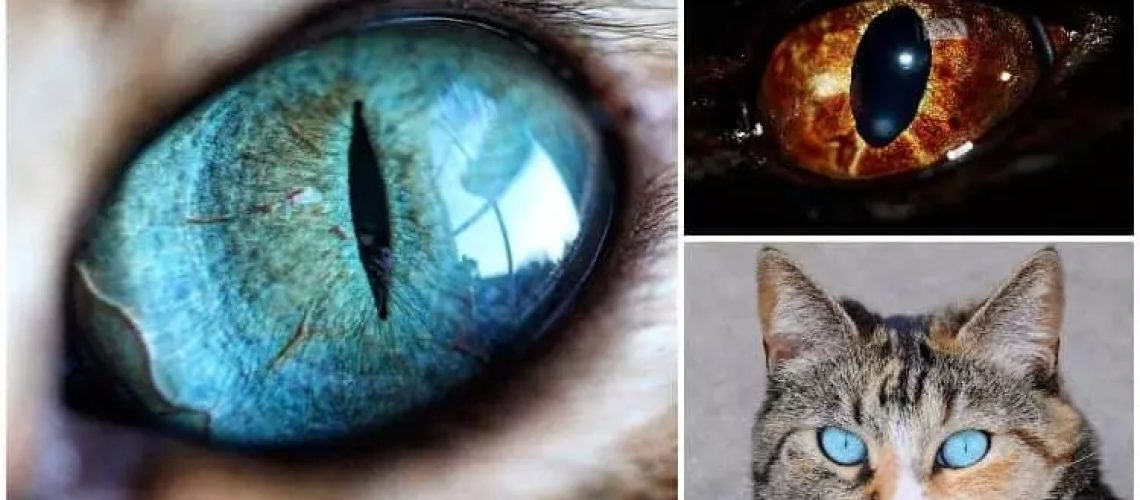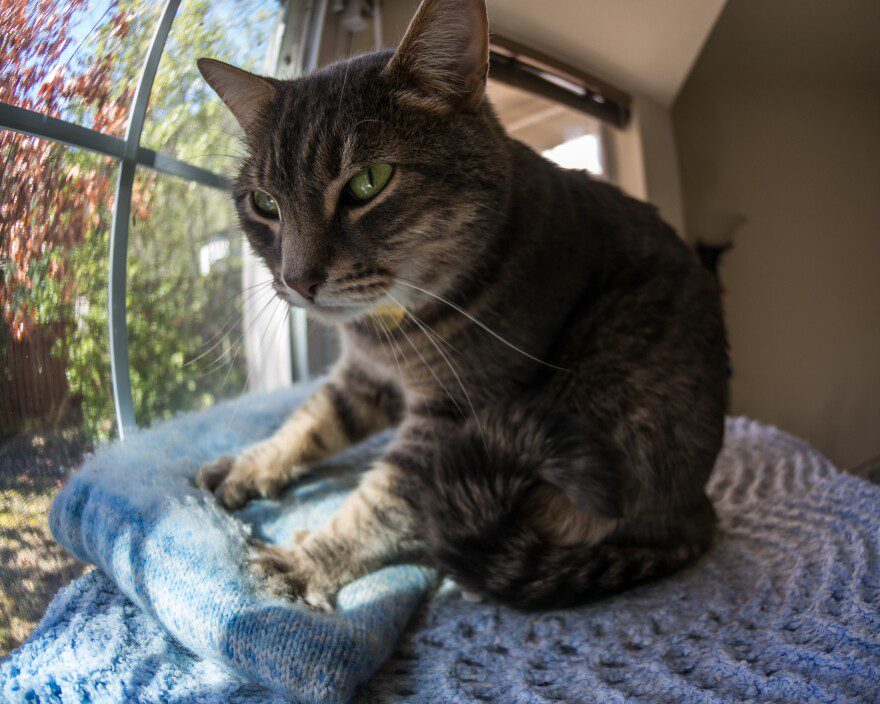Discover the secrets of cats extraordinary eyes! From night vision to a wider field of view, find out what makes them truly unique.
Key Takeaways:
- Cats have a unique eye structure that allows them to see in low light conditions.
- Their vertical pupils help them estimate distance and accurately judge their prey.
- Cats have a reflective layer behind their retina called the tapetum lucidum, which enhances their night vision.
- They have a wider field of vision than humans, with a range of approximately 200 degrees.
- Cats' eyes can change color due to various factors such as age, health, and emotions.
What makes cats' eyes special compared to other animals?
Cats have a unique set of eyes that make them stand out among other animals. One fascinating feature is their ability to see in the dark. Cats have a layer of tissue called the tapetum lucidum located behind their retinas. This layer reflects light back through the retina, giving it a second chance to capture images. It acts like a mirror, maximizing the amount of light available for vision. This is why cats' eyes seem to glow in the dark.
In addition to their exceptional night vision, cats also have an impressive field of view. While humans have a field of view of about 180 degrees, cats can see up to 200 degrees! Their eyes are positioned on the front of their head, providing them with excellent depth perception and allowing them to accurately judge distances.
The Tapetum Lucidum
The tapetum lucidum is a unique structure found in many nocturnal animals, including cats. It plays a crucial role in enhancing their night vision capabilities. The tapetum lucidum reflects light back through the retina, giving photoreceptor cells a second chance to detect photons and create visual signals for the brain.
This reflective layer also contributes to another interesting characteristic of cats' eyes – their ability to shine in low-light conditions. When light enters a cat's eye at night or in dimly lit environments, it passes through the retina and hits the tapetum lucidum before being reflected back out. This reflection creates that eerie glow commonly associated with cats' eyes.
Field of View
A cat's field of view is wider than that of humans due to their unique eye placement. While humans have forward-facing eyes with overlapping fields of view, which provides good depth perception, cats have eyes positioned more to the sides of their heads. This lateral placement allows them to see a broader range of their surroundings without needing to turn their heads.
Having a wider field of view is advantageous for cats as it helps them detect potential prey or predators from various angles. It also enables them to have better peripheral vision, making it harder for anything to sneak up on them.
Quick Facts:
- Cats' eyes have a reflective layer called the tapetum lucidum that enhances night vision.
- The tapetum lucidum reflects light back through the retina, giving photoreceptor cells a second chance to detect photons.
- Cats have a wider field of view than humans due to the lateral placement of their eyes on their head.
How do cats see in the dark with their eyes?
Cats have a unique ability to see in low light conditions, which allows them to navigate and hunt effectively during the night. This is due to several adaptations in their eyes. Firstly, cats have a larger cornea and pupil compared to humans, allowing more light to enter the eye. Additionally, they possess a reflective layer called the tapetum lucidum located behind the retina. This layer reflects light back through the retina, giving it a second chance to be detected by the photoreceptor cells. This enhances their sensitivity to dim light and improves their night vision.
Furthermore, cats have a higher concentration of rod cells in their retinas compared to humans. Rod cells are responsible for detecting motion and shapes in low light conditions. This abundance of rod cells enables cats to perceive movement more effectively than humans in darkness.
In conclusion, cats' ability to see in the dark is attributed to their larger cornea and pupil, presence of the tapetum lucidum, and higher concentration of rod cells in their retinas.
Can cats see colors like humans can?
While cats do not perceive colors as vividly as humans do, they are not entirely colorblind either. Cats primarily have dichromatic vision, meaning they can distinguish between blue and green colors but struggle with differentiating reds from greens or oranges from yellows. This is because they lack certain types of cone cells that are responsible for perceiving these specific colors.
However, despite this limited color perception, cats compensate for it with other visual abilities. They excel at detecting subtle movements due to their high number of rod cells mentioned earlier. Additionally, they have excellent peripheral vision and depth perception which aids them in hunting prey efficiently.
In summary, while cats cannot see the full range of colors that humans can, they possess other visual capabilities that allow them to navigate their environment effectively.
Why do cats have vertical pupils instead of round ones?
The vertical pupils seen in cats, such as those of domestic cats and large wild felines, serve several purposes. Firstly, they allow for a greater range of control over the amount of light entering the eye. By constricting or dilating the pupil vertically, cats can adjust to different lighting conditions more efficiently than if they had round pupils.
Secondly, the vertical shape of their pupils aids in depth perception. The elongated pupil helps create a horizontal line on the retina when looking at objects horizontally. This line assists in judging distances accurately, which is crucial for hunting and navigating their surroundings.
Furthermore, the vertical slit-shaped pupil provides cats with a wider field of view compared to round pupils. This wider field allows them to detect movement from various angles and enhances their ability to spot potential prey or threats.
In conclusion, the vertical pupils found in cats have evolved to provide them with better control over light intake, improved depth perception, and an expanded field of view.
Does a cat's eye shape affect its ability to judge distances?
Yes, a cat's eye shape does indeed impact its ability to judge distances accurately. Cats have forward-facing eyes positioned on the front of their heads, which allows for binocular vision. This means that both eyes work together to create a single image with depth perception.
The position and orientation of a cat's eyes also contribute to its depth perception capabilities. Since their eyes are set slightly apart on their face, each eye receives a slightly different visual input. The brain processes these differences and combines them into one image with depth information.
Additionally, as mentioned earlier, the vertical slit-shaped pupil found in cats aids in judging distances accurately. When observing objects horizontally, this pupil shape creates a horizontal line on the retina that assists in perceiving depth.
Overall, a cat's eye shape, along with its binocular vision and vertical pupil, plays a significant role in its ability to judge distances effectively.
Do all cats have the same eye color, or can it vary?
Cats exhibit a wide range of eye colors, which can vary depending on their breed and genetics. While most domestic cats have yellow or green eyes, other common eye colors include blue, copper, amber, and odd-eyed (each eye having a different color). The specific eye color is determined by the concentration of pigments in the iris.
The presence of melanin determines the intensity of the eye color. Higher levels of melanin result in darker shades such as brown or black, while lower levels lead to lighter hues like blue or green. Additionally, certain genes can influence the presence or absence of pigments in the iris.
It is important to note that kittens are usually born with blue eyes which gradually change to their permanent color as they mature. This change occurs due to the development and distribution of pigments in their irises.
In conclusion, cats can have various eye colors influenced by genetics and breed characteristics. The diversity in feline eye colors adds to their unique beauty and individuality.
Do cats have better night vision than humans? If yes, why?
Yes, cats indeed possess superior night vision compared to humans. Their ability to see clearly in low light conditions is attributed to several factors. Firstly, cats have a larger cornea and pupil compared to humans. This allows more light to enter their eyes, enhancing their sensitivity to dim light.
Additionally, cats possess a reflective layer called the tapetum lucidum located behind the retina. This layer reflects light back through the retina for a second chance at detection by photoreceptor cells. Consequently, even small amounts of available light are maximized for improved night vision.
Furthermore, as mentioned earlier, cats have a higher concentration of rod cells in their retinas compared to humans. Rod cells are specialized photoreceptor cells responsible for detecting motion and shapes in low light conditions. The abundance of these cells enables cats to perceive movement more effectively than humans in darkness.
In summary, cats' superior night vision is due to their larger cornea and pupil, the presence of the tapetum lucidum, and a higher concentration of rod cells in their retinas.
What are some common eye problems that can affect cats?
Cats can experience various eye problems that may require veterinary attention. Some common eye conditions seen in felines include:
Conjunctivitis:
Also known as pink eye, conjunctivitis is characterized by inflammation of the conjunctiva (the thin membrane covering the inner surface of the eyelids and the white part of the eye). It can be caused by infections, allergies, or irritants and may result in redness, discharge, swelling, and discomfort.
Cataracts:
Cataracts refer to the clouding of the lens inside a cat's eye. This condition can cause blurred vision or even complete blindness if left untreated. Cataracts may develop due to genetic factors, aging, diabetes mellitus, or trauma.
Corneal Ulcers:
Corneal ulcers are open sores on the cornea (the clear outer layer of the eye) that can occur from injury or infection. They often cause pain, excessive tearing, squinting, redness, and discharge. Prompt treatment is necessary to prevent complications and promote healing.
Other common eye problems include:
- Glaucoma: Increased pressure within the eye leading to optic nerve damage.
- Entropion: Eyelids folding inward, causing irritation and corneal damage.
- Uveitis: Inflammation of the uvea (middle layer of the eye) resulting from infections, trauma, or autoimmune diseases.
- Cherry Eye: Prolapse of the third eyelid gland, causing a red mass to protrude from the corner of the eye.
If you notice any signs of eye problems in your cat, it is essential to seek veterinary care for proper diagnosis and treatment.
How can you tell if a cat is happy or scared based on their eyes?
A cat's eyes can provide valuable insight into their emotional state. Understanding certain visual cues can help determine whether a cat is happy or scared. Here are some indicators:
Happy Cat:
- Dilated pupils: When a cat is content and relaxed, its pupils are usually dilated. This indicates a sense of comfort and trust.
- Squinting or blinking: Slow blinking or squinting eyes are often seen as signs of affection and relaxation. It suggests that the cat feels safe and at ease in its environment.
- Soft gaze: A happy cat will have a gentle and relaxed expression in its eyes. The overall appearance is calm and content.
Scared Cat:
- Dilated pupils with wide-eyed stare: When a cat feels threatened or frightened, its pupils may dilate significantly. The eyes appear wide open as the cat tries to take in as much information as possible to assess potential dangers.
- Tense body language: Fearful cats often exhibit tense body postures along with wide-eyed stares. They may crouch low to the ground or try to make themselves appear smaller.
- Avoiding eye contact: Scared cats may avoid direct eye contact and avert their gaze. This behavior is an attempt to appear less threatening and vulnerable.
It is important to note that these visual cues should be considered in conjunction with other behavioral signs to accurately assess a cat's emotional state. Each cat is unique, and individual differences should be taken into account when interpreting their eye expressions.
| In Conclusion | |
| Cats' eyes are truly remarkable! | With their unique structures and abilities, cats possess some of the most fascinating eyes in the animal kingdom. From their vertical pupils to their exceptional night vision, these mesmerizing features make them efficient predators and beloved companions. |
| A window into their mysterious world | Cats' eyes provide a glimpse into their secretive nature and unparalleled sensory perception. Their ability to see in low light conditions, detect motion with precision, and communicate through subtle expressions truly sets them apart. |
What are the rarest cat eyes?
The rarest eye color for cats is orange, copper, or amber. Cats with eyes in the orange range have a deep orange color, similar to copper or brown. These cats with the darkest eyes are also the least common, with blue eyes in adult cats being the second rarest.
What is unique about a cat's eyes?
What sets cat eyes apart from those of other animals? While cats' eyes are similar to the eyes of humans and other mammals, they have a unique reflective structure called the "tapetum lucidum" located near the retina. This structure acts as a mirror, reflecting light back onto the retina.
What do the colors of cats eyes mean?
A cat's eye color is determined by their genetic makeup. The amount of melanin present, which is responsible for the color of their eyes, skin, and fur, plays a significant role. The more melanin they have, the darker their eye color will be.
What breed of cat has different eyes?
Numerous cat breeds, such as Van cat, Turkish Van, Turkish Angora, Sphynx, Persian, Oriental Shorthair, Japanese Bobtail, and Khao Manee, are known for their odd-eyed appearance. In Turkey, Ankara Zoo is actively working to protect and maintain a population of pure white Turkish Angora cats with blue and amber eyes through their breeding program.
What is a diamond eye cat?
The Khao Manee, also called White Gem, Khao Plort, and Diamond Eye cats, originated from Thailand and are considered an ancient breed associated with good luck. They are recognized for their white fur, brightly colored eyes, and athletic physique.
What is the rarest color in cats?
Out of all the different colors that cats can have, albino is the most uncommon. Albino cats lack pigmentation, resulting in pink skin, white fur, and pale blue or pink eyes.

















